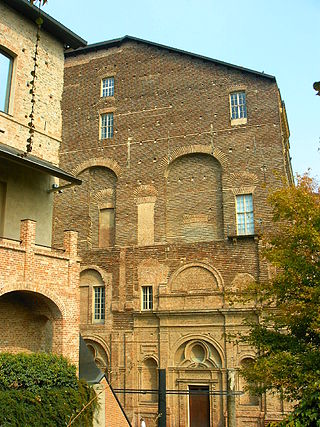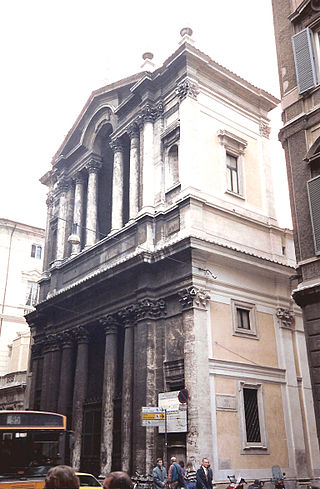History
It's named after the hill, overlooking the town of Bosa, on which it was built by the ancient Tuscany Malaspina family in the 13th century. [1] It is on top of the hill of Serravalle, and it can be reached by a long, steep staircase. The first nucleus of the Serravalle Castle was built on the homonymous hill: the date of its construction, traditionally fixed in 1121 by the humanist and historian Giovanni Francesco Fara [2] is to be postponed, with the contribution of the excavations conducted by the archaeologist Marco Milanese, around the second half of 13th century [3]
In the vast Place-of-arms is located the small church of Our Lady de Sos Regnos Altos, the palatine chapel of the castle. In the interior of the sanctuary there are series of frescoes dating from the 14th century. [4]

Vigevano is a comune (municipality) in the province of Pavia, in the Italian region of Lombardy. A historic art town, it is also renowned for shoemaking and is one of the main centres of Lomellina, a rice-growing agricultural district. Vigevano received the honorary title of city with a decree of Duke Francis II Sforza on 2 February 1532. It is famed for its Renaissance Piazza Ducale in the centre of the town.

Vittorio Veneto is a city and comune situated in the Province of Treviso, in the region of Veneto, Italy, in the northeast of Italy, between the Piave and the Livenza rivers, borders with the following municipalities:

The Visconti of Milan are a noble Italian family. They rose to power in Milan during the Middle Ages where they ruled from 1277 to 1447, initially as Lords then as Dukes, and several collateral branches still exist. The effective founder of the Visconti Lordship of Milan was the Archbishop Ottone, who wrested control of the city from the rival Della Torre family in 1277.

The Castello Sforzesco is a medieval fortification located in Milan, Northern Italy. It was built in the 15th century by Francesco Sforza, Duke of Milan, on the remnants of a 14th-century fortification. Later renovated and enlarged, in the 16th and 17th centuries it was one of the largest citadels in Europe. Extensively rebuilt by Luca Beltrami in 1891–1905, it now houses several of the city's museums and art collections.

Poggibonsi is a town in the province of Siena, Tuscany, central Italy. It is located on the River Elsa and is the main centre of the Valdelsa Valley.

Sinalunga is a town and comune in the province of Siena, in the Tuscany region of central Italy.

Malcesine is a comune (municipality) on the eastern shore of Lake Garda in the Province of Verona in the Italian region Veneto, located about 120 kilometres northwest of Venice and about 40 kilometres northwest of Verona. It is one of I Borghi più belli d'Italia.

The Rivoli Castle is a former Residence of the Royal House of Savoy in Rivoli. It is currently home to the Castello di Rivoli – Museo d'Arte Contemporanea, the museum of contemporary art of Turin.

Santa Maria in Via Lata is a church on the Via del Corso, in Rome, Italy. It stands diagonal from the church of San Marcello al Corso.

The Civic Museums of Pavia are a number of museums in Pavia, Lombardy, northern Italy. They are housed in the Castello Visconteo, or Visconti Castle, built in 1360 by Galeazzo II Visconti, soon after taking the city, a free city-state until then. The credited architect is Bartolino da Novara. The castle used to be the main residence of the Visconti family, while the political capital of the state was Milan. North of the castle a wide park was enclosed, also including the Certosa of Pavia, founded 1396 according to a vow of Gian Galeazzo Visconti, meant to be a sort of private chapel of the Visconti dynasty. The Battle of Pavia (1525), climax of the Italian Wars, took place inside the castle park.
The following is a timeline of the history of the city of Genoa, Liguria, Italy.

Vintebbio is a frazione of the municipality of Serravalle Sesia, in Piedmont, northern Italy.
Montebamboli is a hamlet and località in the comune of Massa Marittima, Tuscany, Italy. The settlement was first mentioned in a parchment from the year 754, and it is located in the hills of what is now the centre of Massa Marittima, within the Parco interprovinciale di Montioni. The hamlet is one of the few still preserved in its original state in the area, containing about twenty farms and a complex centred on the historic Petrocchi farm dating to the early 19th century, which still has its old wine cellar and olive press. There is a church dedicated to St. Francis and St. Louis, dating to the late 18th century.

Camillo Camilliani was an Italian architect, military engineer and sculptor. He is mostly known for the design of watchtowers and other fortifications around the coasts of Sicily.

Rocca Orsini is a Middle Ages castle in Scurcola Marsicana, Province of L'Aquila (Abruzzo).

The Castle of the Pico is a castle in the city center of Mirandola, in the province of Modena, Italy.

The Visconti Castle or Castello Visconteo of Cassano is a castle of medieval origin in Cassano d'Adda, Lombardy, Northern Italy. Its current form dates back to the 14th century, when Bernabò Visconti, lord of Milan, enlarged the existing fortification as part of a defensive system of the Visconti dominions on the Adda river. At the end of the 20th century, after a period of abandonment, it was restored and transformed into a hotel.

The Arese are a prominent family of the Milanese nobility.

















